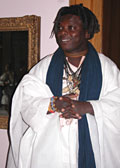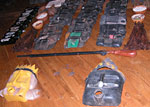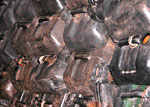You are here: Reports » Phase 2: exhibitions » Art » Carrying the past...
Carrying the past into the present: Romuald Hazoumé, 'La Bouche du Roi'
Dr. Michael White, University of York
Romauald Hazoumé's 'La Bouche du Roi', is forming a significant part of the commemoration of the 1807 Abolition Act as it tours various museums in Britain. The provocative 'La Bouche du Roi' has impressed audiences with its strong, engaging construction, which speaks of the issues of enslavement, by reworking the 1789 Brookes image of the slave ship. The piece plays upon the centrality that the slave ship has in the memory of enslavement throughout the countries involved in the Atlantic slave trade. Dr. Michael White, University of York, discusses these issues and how Hazoumé work communicates the suffering of the 'Middle Passage', but significantly how it also expresses the fears and hopes of our own world.
Origins
'My piece is not talking about old slave ships; it's about what happens today.' Romauald Hazoumé is absolutely clear that, in his view, slavery has not ended; it has merely changed its form and the installation 'La Bouche du Roi', recently purchased by the British Museum and exhibited this year in connection to the bicentenary of the Abolition of the Slave Trade Act makes powerful connections between past and present.

Detail from 'La Bouche du Roi'
Photo: Helen Weinstein
Copyright: Romauald Hazoumé,
Courtesy: October Gallery
Larger image (43KB)
The work was initially created in 1997, shown for the first time in Benin in 1999 and then toured through various European galleries. At that time it comprised the form of 304 'masks' made from petrol cans laid out in the image of the woodcut of the Brookes slave ship produced in 1789 for the anti-slavery campaigner Thomas Clarkson. 'I made it for my people,' according to Hazoumé, people he thinks have 'forgotten where they come from' and the opening of the work in Benin was accompanied by traditional food, drink and music as a demonstration of what is being lost by those who are now 'following Coca-Cola culture,' in his words. In 2005, when shown at the Menil Collection in Texas, Hazoumé added a film to the installation showing the smuggling of petrol between Nigeria and Benin using the same petrol cans. This has added a new dimension to the work for a European and American audience who may be ignorant of the oil business in West Africa. The work's significance, according to Neil McGregor, director of the British Museum, is as a document of how West Africans view the slave trade today. It will be shown in five cities and six different venues in the UK over the next year or so, making an interesting intervention in the events commemorating abolition.

The artist, Romauald Hazoumé
Photo: Helen Weinstein
Copyright: Romauald Hazoumé,
Courtesy: October Gallery
Larger image (31KB)
Issues
The title of the work, which translates as 'The Mouth of the King' is taken from the name of the estuary of the Mono River and refers to the tidal exchange between the sea and the land that takes place there. Not just a point of disembarkation, 'La Bouche du Roi' is where the sea also brings things to the land. Historically this has been in terms of trade and accompanying the petrol can 'masks' in the installation are gin bottles, tobacco, beads, shells, spices, mirrors and textiles. 'Masks' representing two kings are placed at the stern of the ship, one yellow, standing for the white ruler imposed by the French on Benin, and one black, standing for the king of Benin. Under a gun and a set of scales, these two figures agree the selling of people into slavery with equal blame. Hazoumé has little faith in the dealings of contemporary African leaders with multinational companies and the film reinforces his use of the image of the ship by documenting people trapped in an economic arrangement beyond their control, enslaved by a system that forces them to risk their lives to acquire a commodity (petrol) that West Africa is supposedly rich in.

Detail from 'La Bouche du Roi'
Photo: Helen Weinstein
Copyright: Romauald Hazoumé,
Courtesy: October Gallery
Larger image (56KB)
The horror of the slave ship is evoked in 'La Bouche du Roi' by the piling up of the 'masks' which overlap each other. The smell of urine and faeces is also faintly present which combines with the tobacco and spices to form a musty, human aroma. Several of the 'masks' are broken and the sounds of people calling out in the indigenous languages of Benin fill the darkened room in which it is exhibited. What has been frequently used as an icon for the experience of the black diaspora is here made to reference the continent of Africa today. These figures are undergoing the middle passage without actually leaving the place of their birth. According to the pamphlet produced by the British Museum to accompany the exhibition, 'Every petrol can mask represents a living person with a name, a voice and beliefs.' This is indicated by the attachment to the 'masks' of beads, feathers and small wooden figures, which are related to the costume and customs of the Yoruba people. They are marked by other distinguishing features, such as coloured paint and traces of text, used by their previous owners as means of identification. The motivation to individualise the 'masks' is in direct opposition to the dehumanising effect of their treatment otherwise as goods or cargo. The addition of cultural artefacts points to the survival of an original identity despite the traumatic upheaval of the experience the enslaved people are undergoing.

Detail from 'La Bouche du Roi'
Photo: Helen Weinstein
Copyright: Romauald Hazoumé,
Courtesy: October Gallery
Larger image (60KB)
Impact
By appropriating the woodcut of the Brookes, Hazoumé has to contend with its complex associations. It is a schematic image which, in its orderliness, tells little of the disarray of the hold where the living and the dead were compressed into one, fetid space. But it was precisely the supposed rationality of transporting people under such conditions that gave the woodcut its power. It was an ironic attack on those who thought such behaviour was reasonable. At the same time, by focussing on the image of the hold, filled entirely with supine black figures, it reinforced notions of black passivity and subordination. 'La Bouche du Roi' is installed on the floor and the viewer sees it from above. In the British Museum a small upper deck was even created to enhance this perspective.
Absent from the woodcut were the slavers themselves and those who supported them, something Hazoumé has sought to rectify partially. However, the image remains most powerful in its depiction of a black collective. The memory of the slave ship and the middle passage has formed an important part of black identity politics in America, the Caribbean and Europe. In these contexts it has become less about the slave trade itself and more about survival, dislocation, the preservation of culture and the development of new identities. Unlike previous works of art and literature that have used the slave ship image, 'La Bouche du Roi' says little of what the history of the slave trade means for Hazoumé's own sense of self. Returning the slave ship icon once more for the abolitionist cause, this time the abolition of something we might call globalisation, Hazoumé is warning us about the present and the future rather than retrieving something from the past. As 'La Bouche du Roi' continues its journey across the UK, having travelled previously between Africa, America and Europe, it will be interesting to see the extent to which viewers agree with him that, 'We continue to be in that Brookes, we all, [...] not only black people but white people too [...] we are in that same boat.'
Effect
Carrying the past into the present, Hazoumé's 'La Bouche du Roi' therefore confronts its audiences with a disturbing image of the Atlantic slave trade which has been reworked to convey present-day humanitarian crises. Its effect on audiences around Britain has been influential in shaping the memory of enslavement and abolition. The reworking by a renowned African artist of an image, used prominently within the British campaign for the abolition of the slave trade, provides a stage on which to reconsider the legacy of both enslavement and the abolitionists. The image has been wrested away from its original context and reemployed to great effect upon contemporary audiences.
Itinerary
'La Bouche du Roi' will be installed in a number of museums throughout 2007-2008:- International Slavery Museum, NML (Liverpool)
4 August - 2 September 2007 - Bristol's City Museum, Bristol
15 September - 28 October 2007 - Laing Art Gallery, Newcastle
10 November - 3 February 2008 - Horniman Museum, London
5 December 2008 - 1 March 2009
Responses
'La Bouche du Roi' provokes a variety of questions regarding the manner in which abolition and enslavement are remembered. If you wish to contribute your opinion to this article and the relevance of Hazoumé's work, email the 1807 Commemorated project team - arch-1807@york.ac.uk
